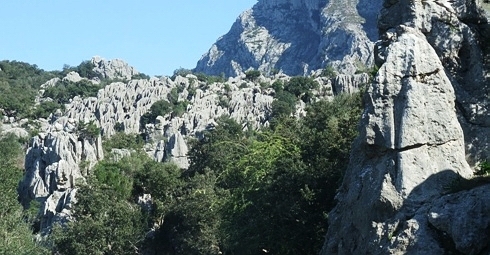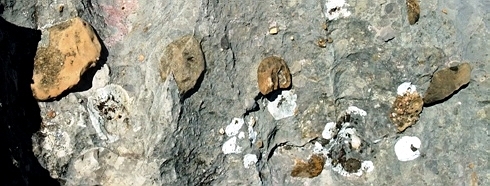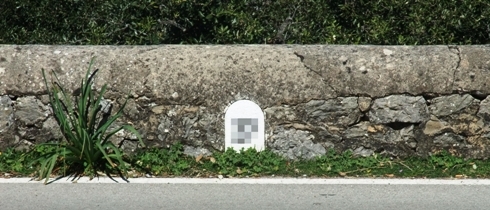Die
Serra de Tramuntana ist ein 90 km langer, zerklüfteter Gebirgszug an der Nordwestküste Mallorcas. Dieser enstand vor mehr als 20 Millionen Jahren, als die afrikanische und die europäische Kontinentalplatte miteinander kollidierten und die Erdkruste unter gewaltigen Schubkräften zu Gebirgen auffalteten.
Die Gesteine der Serra de Tramuntana sind bis zu 250 Millionen Jahre alt. Es handelt sich überwiegend um Kalkgestein, das ursprünglich als Sediment auf dem Meeresboden aus den Überresten von Lebewesen und anderen Ablagerungen gebildet wurde. Durch die Auffaltung zum Gebirge wurde das Gestein über den Meeresspiegel emporgehoben und so der Oberflächenerosion ausgesetzt.
 Karstlandschaft in der Serra de Tramuntana
Karstlandschaft in der Serra de Tramuntana
Die für die Serra de Tramuntana charakteristischen Karstlandschaften entstanden durch Kohlensäureverwitterung des Kalksteins. Dabei wird dieser an der Oberfläche zunächst durch chemische Prozesse ausgelaugt, danach durch mechanische Einflüsse weiter ausgewaschen – es bilden sich die entlang der MA-10 überall im Fels sichtbaren prägnanten Rinnen, die sogenannten
Karren.
 Karstkarren beim EarthCache
Karstkarren beim EarthCache
An den oben angegebenen Koodinaten kann unmittelbar neben der Straße und praktischerweise gegenüber einer Parkmöglichkeit ein Felsblock mit deutlich ausgeprägten Karstkarren betreten werden. Des weiteren sind hier
Brekzien zu sehen, gebildet durch Sandsteinbrocken, die in den noch unterseeischen Kalkschlamm eingesunken sind und danach im sich daraus bildenden Kalkstein als Einschlüsse erhalten blieben.
 Brekzien beim EarthCache
Bedingung für die Logerlaubnis
Brekzien beim EarthCache
Bedingung für die Logerlaubnis
Beantworte die folgenden vier Fragen und sende mir deine Antworten per E-Mail (über das Kontaktformular in meinem GC-Profil). Du kannst dann sofort loggen, ich werde mich melden, wenn etwas nicht stimmt. Fotos sind natürlich willkommen, werden aber nicht ausdrücklich zur Bedingung gemacht.
Frage 1: Wie fühlt sich das Gestein an?
Frage 2: Welche Art Verwitterung hat die Karren hervorgerufen?
Frage 3: Aus welcher Gesteinsart bestehen die Brekzien?
Frage 4: Gegenüber dem Parkplatz steht auf dem Mäuerchen eine Zahl auf weißem Grund. Welche?

The
Serra de Tramuntana is a 90-km-long, jagged mountain range on the northwest coast of Majorca. It originated more than 20 million years ago when the African and the European continental plates collided with each other and folded the earth's crust under immense thrust forces to mountains.
The rocks of the Serra de Tramuntana are up to 250 million years old. It predominantly consists of limestone which was formed originally as a sediment on the seabed from the remains of living beings and other depositions. The rock was raised about sea level when it was folded to mountains and thus was exposed to surface erosion.
 Karst landscape in the Serra de Tramuntana
Karst landscape in the Serra de Tramuntana
The karst landscape which is characteristic of the Serra de Tramuntana originated from carbonic acid dissolution of the limestone. The rock’s surface is initially leached out by chemical processes and washed out afterwards by mechanical influence, building the characteristic
karst pavement which is ubiquitous in the rocks along the MA-10.
 Karst pavement at the EarthCache
Karst pavement at the EarthCache
At the coordinates given above a limestone boulder with well-marked karst pavement can be entered. It is situated immediately beside the street and conveniently oposite to a place to park. Furthermore you will see
breccia, formed by chunks of sandstone that sunk into the underwater lime mud and were preserved as inclusions in the limestone afterwards.
 Breccia at the EarthCache
To log this EarthCache
Breccia at the EarthCache
To log this EarthCache
Answer the following four questions and send me your answers throught the contact form in my GC profile. You may log at once, I'll contact you if something is wrong. Photos are welcome but not formally required.
Question 1: How does the rock feel to the touch?
Question 2: What kind of weathering formed the karst pavement?
Question 3: Which type of rock made the breccia?
Question 4: Opposite to the parking place there is a number at the wall on white ground. Which one?

La
Sierra de Tramuntana en la costa noreste es una sierra segmentada de 90 km de longitud. Se formó hace mas de 20 millones de años cuando las losas placas continentales africanas y europeas colisionaron y la corteza terrestre se dislocó por las fuerzas de empuje enormes.
La Sierra de Tramuntana tiene varias decenas de millones de años. Principalmente se compone de piedra caliza, que se había formado originalmente como sedimento sobre el fondo del mar de los restos de las criaturas y otras capas. Por la dislocación de la sierra la roca sobre el nivel del mar la superficie de la roca está expuesta a la erosión.
 Carst en la Sierra de Tramuntana
Carst en la Sierra de Tramuntana
El paisaje caracteristico de Karst de la Sierra de Tramuntan se formó por la erosión de la piedra caliza mediante el acido carbónico. Primero se erosiona la superficie del piedra por influencias mecanicas y se forman las grieta llamadas
Lapiaz, que se ven en toda la roca a lo largo de la MA-10.
 Lapiaz al EarthCache
Lapiaz al EarthCache
En las coordenadas mencionadas existe la posibilidad de aparcar al lado. Enfrente se puede entrar en una cueva con Carst Lapiaz muy pronunciado. Ademas hay
brechas formadas por piedra arenisca, que se han colocado encima del lodo marino. Se han conservado como inclusiones en la piedra caliza.
 Brecha al EarthCache
Por favor, responde a preguntas siguientes por E-Mail.
Brecha al EarthCache
Por favor, responde a preguntas siguientes por E-Mail.
(Fotos estan bienvenidas, pero no son condicion explicita.)
Pregunta 1: ¿Cómo es el tacto de la roca?
Pregunta 2: ¿De que tipo esta la erosión causado para?
Pregunta 3: ¿Qué tipo de roca hizo la brechas?
Pregunta 4: Enfrente del aparcamiento hay un número en la pared en la tierra blanca. ¿Qué?>
